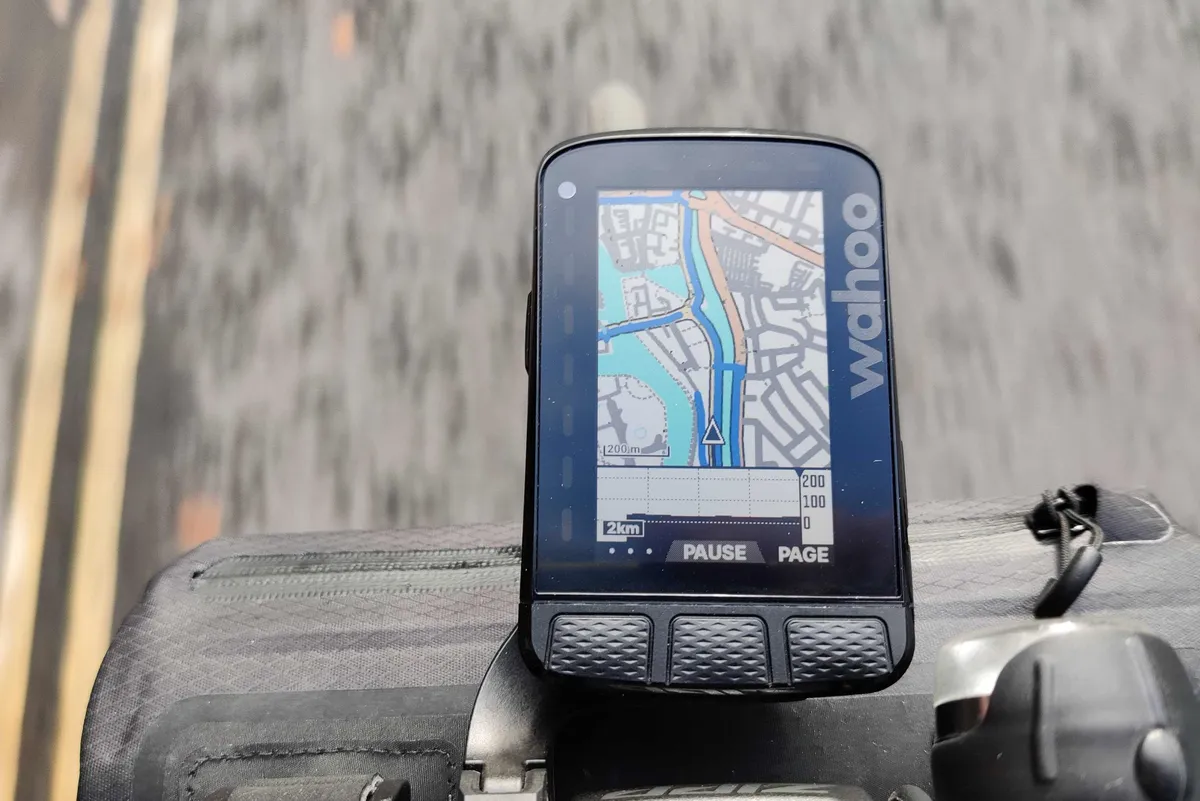Wahoo is a major player in the cycling computer market. Its three bike computers stretch from small-format to very large and provide comprehensive ride-logging and training functionality – along with a wide range of other functions.
How do the three Wahoo cycling computers compare and what do they offer?
We’ll run through the basics here, but you can find out more in our detailed review of each model by following the links below.
Wahoo Elemnt bike computer range explained
Wahoo’s first cycling computer was the Elemnt. That was superseded by the Roam and Bolt, both of which have been upgraded since launch while keeping the same formats.
For a long time, Wahoo had only these two cycling computers in its range. They’re both fairly compact, but upgrades in version 3 included longer battery lives, as well as larger screens with more colours. The Elemnt Roam V3 also gained a touchscreen for the first time.
In late 2024, the brand launched the Elemnt Ace, which is much larger – in fact, larger than any of its major cycling computer competitors – with a touchscreen as well as the same button layout as the Bolt and Roam. It also includes a wind pressure sensor.
At the same time, Wahoo has moved support for the Elemnt Ace from the Elemnt companion app to the Wahoo app and redeveloped the supporting software, with a rolling programme of upgrades scheduled.
Current Wahoo Elemnt bike computer range
Wahoo Elemnt Ace
SQUIRREL_TEXT_13161761

- £549.99 / $599.99 / €599.99 / AU$999.99
- Pros: Sharp screen; good mapping; wind-speed data; easy to use; lower priced than premium Garmin computers
- Cons: Large and heavy unit; some functionality not present at launch
The Elemnt Ace is Wahoo’s flagship cycling computer. Launched in December 2024, it was the first Wahoo computer with a touchscreen. In our review, we found it responsive, while it offers more colours and pixels than Wahoo’s other computers.
This leads in particular to clearer, more detailed maps, which are augmented by voice commands when using navigation.
It also includes a wind pressure sensor in its front edge, which provides a colour-coded assessment of wind boost or drag when riding and for analysis after a ride.
Its 3.8-inch touchscreen is also class-leading, although along with the large battery to support the 30 hours' claimed battery life, it results in a large, heavy unit.
- Read more: Wahoo Elemnt Ace review
Spec
- Navigation: Full colour with detailed basemap, and colour-coded road types and off-road routes, voice commands for navigation, re-routing
- Training data: Frontal wind speed, speed, distance, time, elevation, heart rate and power data fields, Summit segments and more
- Storage: 64GB
- Connectivity: Dual-band GPS, ANT+, Bluetooth, Wi-Fi, USB-C
- Compatibility: ANT+ and BLE sensors, rearview radar, Wahoo app
- Size: 119x60x16mm
- Screen: 3.8 inches, 16m colour touchscreen, 480x720 pixels
- Weight: 206g
- Claimed battery life: 30 hours
SQUIRREL_13161761
Wahoo Elemnt Roam V3

SQUIRREL_TEXT_13205840
- £399.99 / $449.99 / € 449.99 / AU$749.95
- Pros: Relatively compact; easy configuration via Elemnt App; LEDs for quick metrics
- Cons: Fairly small screen; middling battery life
The Wahoo Elemnt Roam V3 is much smaller than the Elemnt Ace, with its updated colour touchscreen taking up a smaller proportion of the case’s front too. There are fewer pixels and a less detailed map than with the Ace, although data fields should still be easy to read.
The supplementary LED lights featured on the Roam V2 have been removed, allowing the screen size to grow slightly, from 2.7 to 2.8in. The screen can also now display 16 million colours, up from just 64 on the Element Roam V2.
Battery life has also increased to "up to 25 hours", a large increase over the V2's 17 hour capacity.
The Elemnt Roam V3's touchscreen enables you to pinch, zoom and swipe on screen, but the three buttons at the bottom of the screen, plus those on the sides of the device, are retained for better functionality with winter gloves or in wet weather.
That aside, much of the Roam's functionality mirrors the Ace, with options including climb profiles, although navigation uses on-screen prompts without the Ace’s voice commands.
While the Elemnt Ace links into the Wahoo app, the Roam and Bolt still use the separate Elemnt app. This enables you to configure the unit on your phone, provides post-ride analysis and will give you live tracking if you carry your phone on a ride.
Spec
- Navigation: Colour with basemap with off-road routes, navigation, re-routing
- Training data: Speed, distance, time, elevation, heart rate and power data fields, Summit segments and more
- Connectivity: Dual-band GPS, ANT+, Bluetooth, Wi-Fi, USB-C
- Compatibility: ANT+ and BLE sensors, rearview radar, Elemnt app
- Screen: 2.7 inches, 16m colour touchscreen
- Claimed battery life: Up to 25 hours
SQUIRREL_13205840
Wahoo Elemnt Bolt V3

SQUIRREL_TEXT_13205841
- £299.99 / $329.99 / €329.99 / AU$549.99
- Pros: Small format; low weight; aero mount; sleek looks
- Cons: Button-only; small screen; awkward navigation
The Wahoo Elemnt Bolt is the racer’s choice thanks to its small size and light weight. Wahoo also claims its integrated out-front mount is more aerodynamic.
While the Roam V3 gained a touchscreen, the Elemnt Bolt V3 remains button-operated only, with three buttons at the base of the screen.
The V3 does get a slight bump in screen size, however, up from 2.2in to 2.3in – which has been partly achieved by removing the LED lights the Elemnt Bolt V2 used above its screen. As on the Roma V3, Wahoo says Bolt V3's new screen can display 16 million colours.
The Elemnt Bolt V3 also gets a boost to battery life, which is now “up to 20 hours”, compared to 15 on the previous version.
The trade off for its compact size is that the small screen naturally limits the number of data fields you can display, though these are user-configurable to display key data.
While we’ve yet to test the Elemnt Bolt V3, we found the small screen on the V2 made navigation for exploring awkward; if that’s something you want, Wahoo’s larger computers may be a better bet. However, if you just want to know your key stats and follow the route of a race or ride, the Bolt is a bijou, relatively affordable option.
Spec
- Navigation: Colour with basemap with off-road routes, navigation, re-routing
- Training data: Speed, distance, time, elevation, heart rate and power data fields, Climber and more
- Connectivity: Dual-band GPS, ANT+, Bluetooth, Wi-Fi, USB-C
- Compatibility: ANT+ and BLE sensors, rearview radar, Elemnt app
- Screen: 2.3 inches, 16m colour touchscreen
- Claimed battery life: Up to 20 hours
SQUIRREL_13205841
What can Wahoo Elemnt bike computers do?

Wahoo computers connect very closely to Wahoo’s smartphone apps – the Wahoo app for the Elemnt Ace and the Elemnt app for the Roam and Bolt. That makes initial setup very easy. You scan a 3D barcode on the device to pair up your phone, then set everything up in the app.
Other brands are still only just catching up with this feature, which makes changes straightforward. You can change the data fields displayed, for example, in the phone app. You can also create or choose a route to follow, along with other functions that would be fiddly to perform on the cycling computer itself.
All Wahoo Elemnt cycling computers display a basemap to show your location, which is found using dual-band GPS for a more precise position fix that's less likely to deviate under trees or around large buildings.
Wahoo also uses this to provide turn-by-turn navigation when following an uploaded route, with turn alerts on screen augmented by voice commands on the Elemnt Ace. It can also reroute you should you go off-course.
Beyond the basic how far, how fast, how long and other data, you can pair up your Wahoo computer with other devices, such as a power meter, a heart rate monitor or a speed and cadence sensor to provide more data on your performance. You can also link up a rearview radar to provide greater situational awareness.
The phone linkage is also used to provide live tracking, where you can allow named third parties to see your location, if you take your phone with you on a ride. You can also set up group rides and share locations with other riders. Wahoo will notify your contacts if it detects an incident, such as a fall (all of this functionality is not yet available but is scheduled to be added later in 2025 for the Ace).
Linking to your phone also provides notifications for incoming text messages, voice calls and emails, if you wish.
You can link your Wahoo computer to other apps, such as Strava or Komoot, to share routes before a ride and to download ride data to them post-ride.
All the Wahoo cycling computers also link up to indoor cycling apps such as Zwift and Wahoo X and smart trainers – both Wahoo’s and those sold by other brands – to enable you to train indoors.
Discontinued Wahoo Elemnt bike computers
Wahoo launched its first Elemnt bike computer in 2015 and it has also updated the Bolt and Roam since launch. Here’s a list of discontinued Wahoo Elemnt computers with a link to our review or news feature for each.
- Wahoo Elemnt
- Wahoo Elemnt Mini
- Wahoo Elemnt Bolt V1
- Wahoo Elemnt Roam V1
- Wahoo Elemnt Bolt V2
- Wahoo Elemnt Roam V2
What other bike computer options are there?

For a long time, Garmin was the main cycling computer brand and it remains the main competitor to Wahoo. Garmin’s bike computer range is broader, with both lower-priced and more expensive models.
We also have a head-to-head of Wahoo vs Garmin cycling computers and a comparison of the flagship devices: Wahoo Elemnt Ace vs Garmin Edge 1050.
Hammerhead, owned by SRAM, has a single cycling computer, the Hammerhead Karoo, now in its third generation. It’s mid-format, but its Android-based operating system offers a smartphone-like user interface and great graphics.
Bryton is a cheaper alternative, with a diverse range of computers, some of which offer premium functionality, while others compete at the lower end of the market.
Giant sells its Dash cycling computers, but we found they didn’t offer the best user experience when we reviewed them.
Lezyne’s range of computers is lower-priced. It does the basics well, but hasn’t been upgraded recently and no new models have been launched for a few years.
Several smartphone cycling apps, including Strava and Komoot, have ride-logging functionality. They can substitute for a cycling computer if you want the basic ride-logging functionality, but mounting your phone to your bike can be tricky – you need to be sure your phone is waterproof or in a case.
Many of the best cycling watches provide all the functionality of a cycling computer in a wearable format. They will track off-bike metrics such as sleep and recovery too. Although they’re trickier to view while riding, you can purchase a bar mount for some to give you on-bike data.
